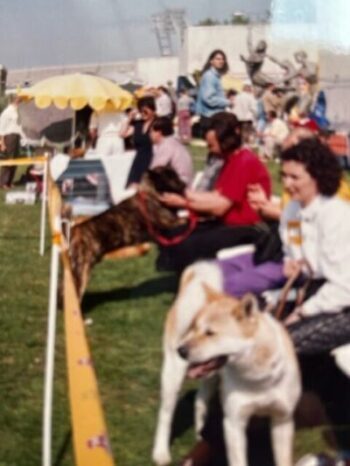
ヨーロッパ(ブタペスト)の展覧会での秋田犬
第六話 感動したこと
私は、社会人になってからも北海道犬のアマチュア研究を始めたいと考えていた。家族で北海道に住んでいたから、実際に展覧会に家の犬を出陳して、犬仲間といつまでも話が尽きなかった。北海道犬を年代に沿って血統や系統別に写真を掲載し、解説した先人たちの素晴らしい記録と業績がある。大概、イヌのすぐれた研究は、大学や研究室からは出てこないと、かつて読んだのか、私のオリジナルの考えなのかわからない。犬が大好きな人たちは、犬を研究するよりも、犬と遊び、一緒に暮らしを楽しむ方がよいに決まっている。「犬は人の鏡」と言われるくらい、人の研究をするに等しい壮大なテーマだと思う。私が知る犬についての探求心にとりつかれた人たちは、”犬道楽“と呼ばれ、犬に時間も財産も費やし、その成果はただちに評価に現れないものの、少なくとも本人たちは、充足感や豊かな想い出に満たされたのではないだろうか?家族や周囲にとっては、とんでもない人たちだったかもしれないが。
日本犬の調査・研究は、1990年代に大学の研究室が予算を獲得して、遺伝子情報(DNA)の専門家が加わって、そのルーツや類似犬種などの分析や解明が行われてきた。北海道犬の調査・研究は、このような先端事例に対し、現状では明らかに出遅れて、停滞している。出遅れても研究成果を挽回できる先端技術を期待したいが、日本犬の各保存会は、自前で調査・研究する資金どころではない、財政状況のようだ。
日ごろの犬の”犬脈”で、夏休みをとって、1993年、AJIKC(仮名;オールジャパン・インターナショナル・ケネル・クラブ)のドッグショーに、事務局スタッフで参加した。開催地はデンマークのコペンハーゲンだった。AJIKCのように国内で最大級の畜犬団体は当時、家畜に分類される犬の生産者団体として分類されて、農林水産省の小動物係が所管していた。ちなみに、秋田犬、甲斐犬、紀州犬、柴犬、四国犬、北海道犬の六犬種の日本犬は、国の天然記念物であり、文化庁の所管であった。AJIKCは、FCI(国際畜犬連盟・本部はベルギーのブルッセル)のメンバーの一員である。FCIは、認定した犬種を世界市場に流通させる国際連合のような組織である。すなわち血統書付き犬種を認定し、血統書付き犬を市場に仲間入りさせる、世界的マーケット機構を運営していた。AJIKCが西洋犬も日本犬も、日本を代表する団体として、このFCIで、議決を要する会議や、ドッグショーの開催に参画する。その結果、犬を生産する商売(業者)と、家庭で犬を家族として扱う人たち(愛犬家)が混在する組織となってしまう。したがって、AJIKCを運営する苦労は、並大抵ではなかったようだ。AJIKCの理事長の口癖は、「クラブの犬の質は格段に向上したが、人間の質の方が追い付かない」というものだった。
コペンハーゲンでは審判団にAJIKCから国際審判の資格を持つ、日本人ジャッジ2名が参加していた。シーズーの部が終わった後、一人の女性が審判席に、その部の主審をした日本のAJIKC所属のジャッジを探しにきた。判定に不満や異論、あるいは相談があることはよくあることらしく、Tジャッジは、やや不安気に、それでも慣れた様子で席から立った。AJIKCの重鎮で、国内外で審判の経験も豊富だった。
「私のこの子は、どうだったのか、説明がほとんどなかった。もっと聞きたい」ということらしい。私の仕事としては、この婦人の言っていることをTジャッジに伝えた。
「一番最後についたアクアちゃんですね。歩行がだいぶ揺れて普通に歩けないでしょう。足を怪我しているのかな?」とT氏が言うと、その婦人は「それはそうですよ。2年前に車と接触して」、でも幸い命は助かったのだというようににっこりして、「後足が元通りに直りません。歩き方は以前のようにはいきません、でもこの子について専門家のコメントやアドバイスがほしくて、ドッグショーに連れてきたのです。コート(毛並み)や顔立ちはとてもきれいだと思っているのですよ」。
一瞬私も周囲も沈黙してしまった。誰よりも、T審判が日頃から会員に、将来のドッグショーのあり方として描いていたそのものだった。1980年代から90年代のAJIKCは、国内のドッグショー出陳頭数も最盛期で、ドッグショーで勝った、負けた、入賞した、失格だったなど、判定順位がドッグショーの関心事だった。犬の飼い主が参考になる丁寧なコメントは省かれ、勝った犬の子犬は高値になるし、親犬も繁殖で引っ張りだこになる。日本国内では、足を引いて歩く犬をドッグショーに参加させる人はいないだろうと推測した。すでに30年近く前に出会った、シーズーを抱えた婦人が、実に自然に、日頃自慢している自分の犬の特徴を専門家からも、肯定してほめてもらえるのか、もっと気を付けることは?と言いたげな質問はその後、深く私の胸にも刻まれた。
(了)

Dog show in Europe, participants at Budapest with Akita inu
Episode 6 🌞 What Impressed Me
I had always wanted to start an amateur study of Hokkaido dogs after I entered the workforce. Since my family had lived in Hokkaido for three years when I was Junior high, I actually exhibited my family dogs at exhibitions and talked forever with my dog friends. There are wonderful records and accomplishments of our predecessors who have published photographs and descriptions of Hokkaido dogs by pedigree and lineage along the chronological lines. I don’t know if I once read or if it was my original idea that in general, excellent research on canines does not come out of universities and laboratories. People who love dogs would surely rather live and play with dogs than to study them. It is said that dogs are the mirror of their owners, and as such, I think this is a grand subject that is equivalent to the study of people. The people I know who are obsessed with dogs are called “dog enthusiasts” and spend a lot of time and money on dogs. Although their efforts and achievements are not immediately recognized, they must have at least been filled with a sense of fulfillment and rich memories. Ironically to their families and others around them, they may have been perceived as terrible people as they would only focus on their research.
In the 1990s, university laboratories in Japan obtained budget for research and studies on Japanese dogs, and specialists in genetic information (DNA) joined them to analyze and clarify their roots and similar breeds. In contrast to these cutting-edge cases, research and studies on the Hokkaido dog were clearly lagging behind and stagnating even at the present time. Although I would like to see modern time technology be used that will allow us to catch up from this delay, it seems that the financial situation of the Japanese dog preservation societies is such that they do not have the funds to conduct research and surveys on their own.
In 1993, I took a summer vacation to participate in the AJIKC (alias: All Japan International Kennel Club) Dog Show as a member of the secretariat staff. The show was held in Copenhagen, Denmark. At the time, the AJIKC was one of the largest domestic dog organizations in Japan and was classified as a livestock dog producer organization under the jurisdiction of the Small Animal Section of the Ministry of Agriculture, Forestry, and Fisheries. Incidentally six breeds of Japanese dogs, Akita, Kai, Kishu, Shiba, Shikoku, and Hokkaido dogs, were national treasures and under the jurisdiction of the Agency for Cultural Affairs. The AJIKC is a member of the FCI (International Federation of Cattle Dogs, headquartered in Brussels, Belgium), which is an international federation of organizations that distribute certified breeds on the world market. In other words, it operated a worldwide market mechanism to certify pedigreed breeds and to bring pedigreed dogs into the market.
The AJIKC represents both Western and Japanese dogs in Japan and participates in meetings that require voting and the holding of dog shows at the FCI. As a result, the AJIKC is an organization that includes both dog breeders and dog lovers. It seems that the hardships of operating AJIKC were extraordinary. The president of AJIKC was fond of saying, “The quality of the club’s dogs has improved dramatically, but the quality of the people has not kept its pace.”
In Copenhagen, the judges included two Japanese judges from the AJIKC who were qualified as international judges. After the Shih Tzu division was over, a woman came to the judges’ table looking for the Japanese judge from AJIKC who had officiated the Shih Tzu division. It seems that dissatisfaction, disagreement, or consultation with the judges were common, and Judge T. stood from his seat, somewhat uneasy, but still looking familiar with the situation. Judge T. was an important figure of the AJIKC with extensive experience as a judge both nationally and internationally.
“There was little explanation of how my girl Aqua performed.” She said wanting to hear more. As for my job, I passed on her words to Judge T. The judge said, “You were the last one, Aqua. Her gait was very shaky, and she probably cannot walk normally. Is her leg injured?” The lady replied, ” Oh yes, my girl had a collision with a car two years ago,” but she smiled as if her girl’s life was saved, and then added, “Her hind legs are not back to normal. But I brought her to the dog show because I wanted some expert comments and advice on Aqua. I think her coat and face are very beautiful.”
For a moment, everyone around me and I became silent. More than anyone else, it was the very thing that judge T had always envisioned as the future of dog shows. In the 1980s and 1990s, AJIKC was at its peak in terms of the number of dogs entered in shows in Japan, and winning, losing, ranking, and being disqualified, were the main concerns of dog shows.
Sincere comments that would help dog owners raise their dogs tend not to be included. Puppies from winning dogs marked high prices, and their parents were sought after for breeding. I guessed that no one in Japan would allow a dog that walks with a limp to participate in a dog show. A lady with a Shih Tzu, whom I had encountered nearly 30 years ago, asked us, quite naturally, whether we could get affirmation and praise from experts for the characteristics of her dog, which she boasts about daily, and what she should pay more attention to. This question was subsequently deeply engraved in my mind.
end


